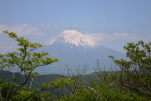Starting in Tokyo, I traveled a circular route to nine locations on the largest island of Japan, Honshu. I spent two weeks in May, 2012, on this first journey to Japan and came home with many memorable impressions and photographs. I selected the "Japan Enchantment" tour from the travel company InsideJapan Tours, which is located in England. Mr. Ota-san, who was the tour leader of our small group of four travelers, was superb in every way. His local knowledge, cultural insights, and careful route planning enabled this successful trip.
Tokyo
I stayed at the Asakusa View Hotel located in the Asakusa neighborhood of Tokyo. The very popular Senso-Ji temple was just a 10-minute walk away. During the day, it seemed millions of tourists had come to see the temple. The temple ground was jammed with people. To avoid them, I decided to photograph the temple at night. After a few days, I quickly learned to tolerate crowds at places of interest, subways, trains, shops, restaurants, and basically everywhere.
Nikko
A two-hour train ride took me from Tokyo to Nikko, a countryside village north of Tokyo. I visited the area around Lake Chuzenji and the Toshogu Shrine, which is designated as a United Nation's World Heritage. The highlight of my visit was viewing the twice-a-year procession at the Toshogu Shrine. I stayed at the Nikko Kanaya Hotel.
Karuizawa
Located in a mountainous region called Japan Alps, the town of Karuizawa is 90 miles away from Tokyo. I stayed two days at Tsuruya Ryokan, a traditional inn. The floor of my room was mostly covered with tatami mats made of rice straws. I sat and slept on the mats. I enjoyed using the traditional communal bath with water from a nearby hot spring. Traditional meals were included in the inn's services. During one meal, I unwittingly ate four thin slices of raw fugu fish, which can be lethally poisonous. Thanks to rigorous government licensing, the chef correctly and safely prepared the fugu fish.
Nagano and Matsumoto
The 1998 Winter Olympic Games were held at Nagano, which is 135 miles from Tokyo. The highlight of my visit was the Jigokudani Wild Monkey Park, where the wild macaque monkeys are habituated to human presence. The monkeys peacefully coexist with their visitors in close proximity, which created wonderful photo opportunities. As a side trip, I traveled to the city of Matsumoto to explore the Matsumoto Castle. I stayed at the Hotel Metropolitan in Nagano.
Kanazawa
I traveled from the east coast of Japan to this west coast city of Kanazawa. Only the Sea of Japan separates Kanazawa from Korea and Russia. As soon as I exited the train station lobby, I saw a large and impressive glass dome supported by metal lattice. The dome shields the weather from passengers waiting for buses. I stayed at Hotel Nikko.
Kyoto and Nara
Kyoto is the ancient capital of Japan at 230 miles west of Tokyo. I stayed at the very grand Granvia Hotel, which is connected to the Kyoto train station. The architecture of the hotel and the train station is very impressive. I visited several Buddhist temples and Shinto shrines, as well as the narrow alleys of central Kyoto that were crowded with restaurants and boutiques. For a day trip, I visited the city of Nara.
Hakone
Hakone is one area in the Fuji-Hakone-Izu National Park that includes the highest mountain (12389 feet) in Japan, Mount Fuji. In order to obtain the best view of Mount Fuji, I first traveled by funicular railway up a steep slope and then transferred to a gondola on the Hakone Ropeway. My destination was Owakudani, where I was extremely fortunate to see Mount Fuji reveal itself from a cloud cover. I stayed at the Fujiya Hotel in the village of Miyanoshita.
Photographic Tools
- digital camera: first generation Canon EOS 5D.
- zoom lens: Canon EF 75-300 mm F4-5.6 III USM.
- zoom lens: Sigma 24-60 mm F2.8 EX DG.
- memory: SanDisk CompactFlash.
- tripod legs: Slik Pro 714 CF II.
- tripod head: Acratech Ultimate Ballhead.
- camera bag: Lowepro Nova 4.
- photo processing: ImageMagick, Canon Digital Photo Professional.






